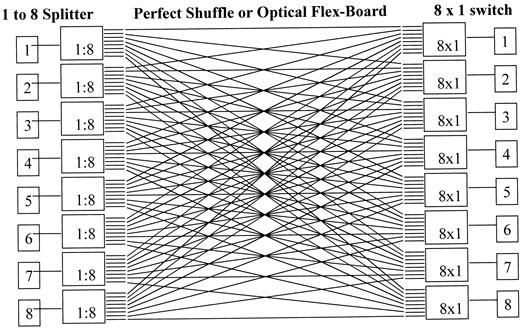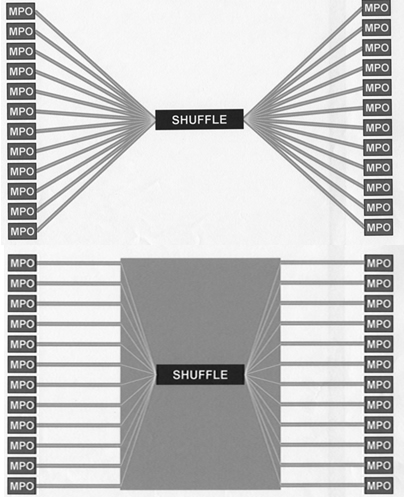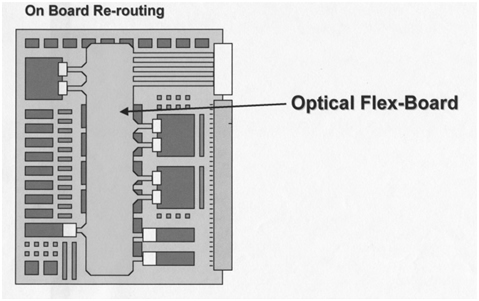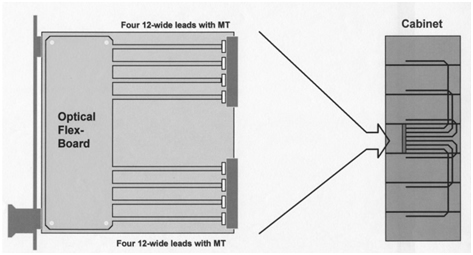Passive Optical Interconnects: Affordable and Scalable for System Integration
Passive optical interconnects optimize datacom, mil/aero, and computer system designs.
 Passive optical components guide transmission of optical signals through optical networks. The concept of flexible optical circuits originated at Bell Laboratories in the late 1980s, and was called Optiflex. Today, interconnects are produced by nearly a dozen companies in a similar manner. Recent technological advances in the design and production of optical interconnects allow equipment suppliers to optimize system designs with a range of specialized interconnect solutions. The ongoing trend is to integrate increasing optical component counts into compact modules and custom solutions. This approach enables system designs for datacom, mil/aero, and computer interconnection markets.
Passive optical components guide transmission of optical signals through optical networks. The concept of flexible optical circuits originated at Bell Laboratories in the late 1980s, and was called Optiflex. Today, interconnects are produced by nearly a dozen companies in a similar manner. Recent technological advances in the design and production of optical interconnects allow equipment suppliers to optimize system designs with a range of specialized interconnect solutions. The ongoing trend is to integrate increasing optical component counts into compact modules and custom solutions. This approach enables system designs for datacom, mil/aero, and computer interconnection markets.
Multi-Fiber Array Connectors for Flexible Optical Routing Circuits
For example, fiber crossovers are designed to minimize stress in optical fibers while providing complex routing of signal pathways. Several companies manufacture multi-fiber array connectors suitable for use with flexible optical routing circuits. These employ precision-molded ferrules as well as micromachined silicon v-grooves for accurate alignment of fibers for optimal coupling configurations. Complex fiber management schemes provide the capability to manufacture flexible fiber routing circuits as well as polymer waveguide-based passive routing components.
One manufacturer, Optical InterLinks (Martra LLC), provides another solution to passive interconnection by creating routing circuits in polymer films. Custom optical circuits are photo-lithographically imaged into photopolymers. Applications include dense-array links, splitters, start couplers, combiners and crossovers, and even sensor read heads and biofluidic products. An additional feature to lithographic waveguide formation is the ability to integrate active components such as dynamic gain equalizing filters, add-drop and wavelength multiplexers, and switches.
Perfect Optical Shuffle for Optical Communications Systems
One key requirement for optical communication systems is the perfect optical shuffle or optical flex board. Eight sets of eight-input fiber arrays are routed to each of eight sets of eight-fiber output arrays. In other words, one fiber from each of the inputs goes to one fiber of each of the outputs. 1:8 splitters are used to create eight sets of eight-fiber inputs; and an 8 X 1 switch is used to direct each of the output fibers to a set of single-fiber outputs. While the specific optical wiring varies from one system application to another, the basic optical shuffle component provides the fundamental building block.
Optical shuffling can be accomplished with various fiber routing and packaging schemes. In one configuration, fibers are ribbonized into 12 sets of 12-fiber arrays, and one fiber from each of the arrays goes to one of the output arrays. The fiber crossovers are housed in a “black box” called the shuffle. A variation of this scheme employs ribbonized fibers entering a sheet of material containing the shuffle routing paths for the fibers. The ribbonized fibers are terminated with optical connectors such as the MPO. This approach is suitable for the variety of multi-fiber connectors available, e.g. MTP, MPX, and other multi-fiber array connectors, as the fibers are ribbonized with 250 um center-to-center spacing. In the assembly process, standard communications-grade optical fiber is laid onto an adhesive substrate material such as Kapton. Following the routing process, a thermoplastic material is laminated over the optical circuit to encapsulate and protect the circuit during handling and environmental extremes.
Interconnection of Optoelectronic Components on a Circuit Card
Another application for optical routing circuits is to provide interconnection of optoelectronic components on a circuit card, such as optical transceivers and processors, as well as make a connection to the card edge or motherboard, and to a routing cabinet. Implementations include crossovers, splitters, couplers, and multiple simplex or multi-fiber termination points. Routing circuits are tailored for each system application. In most cases the only limitations on the fiber routing paths are the minimum radii of curvature allowable for the individual fibers. Encapsulation protects the fibers from debris, moisture, and handling. This provides maximum flexibility to the equipment system designer.
Passive optical interconnects provide a host of options for the equipment designer to integrate subsystems, route connections within and between circuit cards, configure optical circuits, and maintain complexity in smart packaging solutions. Fiber packages and monolithic waveguides integrated with active componentry are available as building blocks for the next generations of computer interconnect and data/telecom systems. Several decades of development resulted in affordable, adaptable, scalable solutions for the most challenging system integration tasks.
By Mark Mentzer, Ph.D., Special Contributor
Figures republished with permission of CRC Press, Taylor and Francis Group, from Applied Optics, Fundamentals and Device Applications, Nano, MOEMS, and Biotechnology, Mark A. Mentzer, Boca Raton, 2011. Permission conveyed through Copyright Clearance Center, Inc.
- State of the Industry: 2022-2023 Connector Sales - April 16, 2024
- Amphenol is On a Roll - April 2, 2024
- Nicomatic Proves That Two Heads are Better Than One - March 26, 2024





